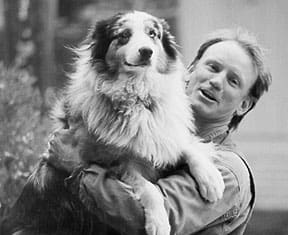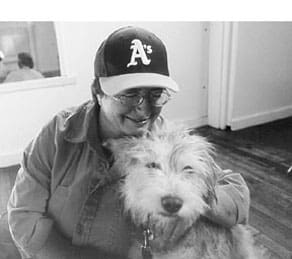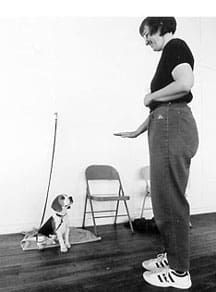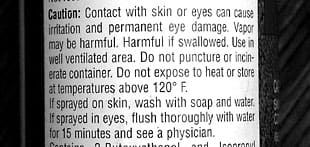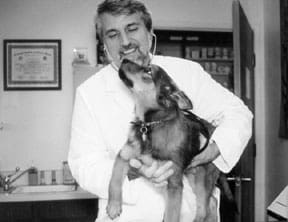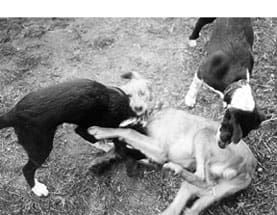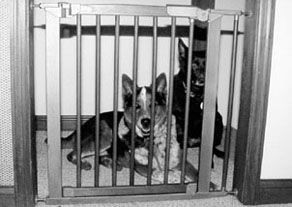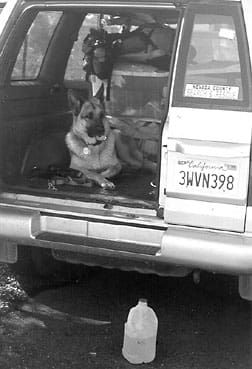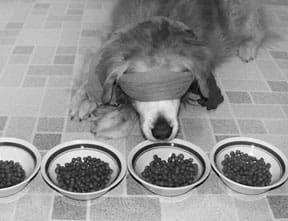[Updated January 9, 2019]
The heartworm (Dirofilaria immitis) is a nematode or roundworm named for its place of residence, inside the heart. To understand the challenge of controlling this parasite, you have to understand its life cycle, a complex and slightly bizarre process.
Living in a dog’s pulmonary arteries, adult heartworms mate. Each female (which can reach sizes of up to 11 inches) produces thousands of eggs, each less than 1/800th of an inch, which are called microfilariae, and circulate in the blood. (A dog who hosts breeding adults may have as many as 10-15 microfilariae circulating in each drop of his blood.) The microfilariae cannot develop any further unless the dog meets up with mosquitoes, which are essential to the parasite’s development.
Heartworm microfilariae conduct the next stage of their life cycle in the mosquito. When a mosquito drinks blood from an infected dog, it obviously drinks in some of the microfilariae, which undergo changes and are called larvae at this stage. They molt twice in the next two to three weeks (and are referred to as L1, L2, and L3 as they molt and change) after entering the mosquito. Then they must leave the mosquito and find a new host or they will die. The larvae move to the mosquito’s mouth, positioned so the insect’s next bite allows them to migrate into the victim’s subcutaneous tissue.
If the mosquito bites an animal that does not host heartworm, the larvae die. If the mosquito bites an animal that heartworms thrive in, the larvae molt again (within three to four days) and take the form (called L4 or “tissue larvae”) they will use to migrate through the dog’s body to reach the circulatory system. It takes the L4 about 60 – 90 days to reach the heart, where, in three to four months, they become adults and begin to reproduce.
Heartworm is most successful when hosted by dogs, red wolves, coyotes, red foxes, and grey foxes.
Wild and domestic felids (cats), ferrets, wolverines, and California sea lions also host heartworm, but its life cycle differs significantly in these species. Few of these animals host adult heartworms that produce microfilariae, which generally die within a month of circulating in the animal’s blood. Also, adult heartworms live for much shorter periods in these animals, compared with five to seven years in the dog.
Humans, bears, raccoons, and beavers are considered “dead-end hosts.” The larval form of the heartworm, transmitted by mosquito bites, do not reach adulthood in dead-end hosts.
Facts about Heartworm (D. immitis)
For heartworms to thrive and become endemic in an area, they require:
1) a susceptible host population (dogs),
2) a stable reservoir of the disease (dogs infected with breeding adults and circulating microfilariae),
3) a stable population of vector species (mosquitoes), and
4) a climate that supports the life cycle of both the heartworm’s reservoir species (dogs and wild canids), its vector species (mosquitoes), and its larval stages within the mosquito. The development of the larvae within the mosquito requires temperatures of about 80 degrees F or above for about two weeks.
Only female mosquitoes suck blood and transmit heartworm microfilariae.
The mosquito is the only known vector for the transmission of heartworm (except for scientists who inject research animals with heartworminfected blood). Heartworm shows a preference for certain species of mosquito. However, during its spread throughout the United States it has adapted well to using other mosquito species as vectors. It has also adapted to a wider temperature range for development of larval stages in the mosquito.
Adult heartworms prefer to live in the heart and in veins leading to it, but they have been found in dogs’ liver, trachea, esophagus, stomach, feces, eye, brain, spinal cord, and vomit.
For more information about heartworm, see the American Heartworm Society’s website.
Effects of Heartworm Infestation in Dogs
The number of adult worms in a dog’s body and the dog’s activity level determine the severity of heartworm disease symptoms.
Sedentary dogs with 25 or fewer worms often remain symptom-free. A dog with a mild heartworm infestation – only a couple of heartworms – may exhibit a mild, occasional cough.
Active dogs with the same number of heartworms and most dogs with 50 or more worms have moderate to severe symptoms. Moderate symptoms may include a cough, exercise intolerance, and abnormal lung sounds.
A dog whose heart is clogged with worms may develop the same symptoms as one with congestive heart failure, including fatigue, a chronic cough, and fluid retention (edema). If adult worms fill the right side of the heart, increased venous pressure can damage liver tissue, alter red blood cells, and lead to blood disorders that cause a sudden, dramatic collapse called caval syndrome. Severe symptoms include a cough, exercise intolerance, difficulty breathing, abnormal lung sounds, radiographs showing visible changes to the pulmonary artery, liver enlargement, temporary loss of consciousness because of impaired blood flow to the brain, edema in the abdominal cavity, and abnormal heart sounds.
Resistance to Heartworm
However, as we have reported before, the immune systems of some dogs seem to be able to wage war, to a limited extent, on the heartworm. An immune-mediated response is thought to be responsible for some dogs’ ability to remove microfilariae from the dog’s circulatory system. And a very healthy dog may be able to outlive a light infestation of adult worms.
This makes sense from a biological perspective. Parasites want to continue their own life cycle; if they kill their host, they kill themselves. Nature’s plan for parasites generally calls for a few hosts to die – thus weeding out weaker individuals of the host species – but for more hosts to live in great enough numbers to provide the parasite with a stable environment.
In order for this to occur, says Richard Pitcairn, DVM, Ph.D., author of the best-selling book, Natural Health for Dogs and Cats, animals in the wild (coyotes, wolves, foxes, and other wild canines) develop a natural resistance to heartworm. “They get very light infestations and then become immune,” he explains. What few people realize, says Dr. Pitcairn, is that many domestic dogs display the same response.
According to Dr. Pitcairn, an estimated 25 to 50 percent of dogs in high-heartworm areas are able to kill (through an immune-mediated response) any microfilariae in their bodies, so they cannot pass along the developing microfilariae. “Also, after being infested by a few heartworms, most dogs do not get more of them even though they are continually bitten by mosquitoes carrying the parasite. In other words, they are able to limit the extent of infestation. All of this points to the importance of the health and resistance mounted by the dogs themselves.”
Despite the extensive use of heartworm preventive drugs, the rate of heartworm infestation in dogs in high-heartworm areas has not declined in 20 years. To Dr. Pitcairn, this statistic proves that drug treatments are not the answer.
Conventional Veterinary Treatments for Heartworm Infection
Years ago, there was only one option offered by conventional veterinary medicine for treating a dog harboring adult heartworms – an arsenic-based drug called Caparsolate that was administered several times intravenously. The treatment was effective, but fraught with potential side effects. Caparsolate has to be injected carefully into the dog’s veins; if even a minute amount comes in contact with muscle or other tissue, it causes horrible wounds accompanied by massive tissue sloughing.
In 1995, Rhone-Merieaux introduced Immiticide, a drug that is injected into spinal muscles, which has quickly replaced Caparsolate as the treatment of choice. This drug, now made by Merial, also presents some side effects, including irritation at the injection site, pain, swelling, and reluctance to move, but none quite as dramatic as the tissue-sloughing danger of Caparsolate.
Post-treatment symptoms are similar with both the old and the new treatment. The drugs kill the adult heartworms, and the dead and decaying worms must work their way out of the dog’s circulatory system. The dead worms are carried in the bloodstream to the lungs, where they are gradually reabsorbed. Depending on the dog’s health and the total number of worms in his system, this can be a mild or a violent process. Dogs usually cough, gag, and vomit, experience fever and lung congestion, and are understandably depressed and lethargic.
Both treatments require the dog to be kept as quiet as possible (preferably caged) for the first few days. All increases in heart rate and respiration force a greater amount of dead worm fragments into circulation. If too many particles flood into the lungs at once, they can block the blood vessels to the lungs and cause death.
Both the Immiticide and the Caparsolate treatments are contraindicated (not recommended) for the most severely infested dogs with Caval syndrome. Ten to 20 percent of dogs with a high worm burden will die as a result of the Immiticide treatment. The number seems grim until you consider that even without treatment, dogs with that level of infestation suffer a much slower, progressively debilitating death. If a heart radiograph, antigen test, or the dog’s symptoms suggest that the infestation is very severe, the dog can undergo a modified treatment protocol, consisting of a single injection, which kills the weaker worms, followed by two more injections a month later.
A dog that experiences difficulties may require extended veterinary care, including administrations of fluids, steroids to reduce any fever or inflammation and help quell the coughing, and supportive therapies for the liver.
After the adult heartworms are killed, the next step in conventional treatment is to kill any microfilariae that are still in circulation. Since the microfilariae cannot mature without an intermediate host (time spent in a mosquito), you’d think you could skip this step. However, at the dose at which they will surely be used to prevent further heartworm infections, heartworm preventive drugs can kill microfilariae at a dangerous rate, potentially causing shock and subsequent death of the dog. The veterinarian will dispense a filaricidal drug and monitor the dog until tests show that the microfilariae are absent from the blood, usually within one to two weeks.
Conventional Veterinary Heartworm Preventive Drugs
All commercial heartworm preventive medicines are targeted to kill heartworm in the “tissue larval” (L4) life stage (after the larvae have been deposited in the dog by an infected mosquito). For this reason, the preventives must be administered within the period of time that begins when the dog is bitten by an infected mosquito and the time it reaches the dog’s circulatory system – about 63-91 days. The preventives do not affect the heartworms once they reach the circulatory system. To provide a safe overlap of time, guaranteeing that any larvae that have been administered to a dog by an infected mosquito are killed before they reach the next, invulnerable life stage, most of the preventives are given every 30 days.
All the preventives listed below kill some (but not all) heartworm microfilariae. If a dog hosts adult, breeding heartworms, has microfilariae in his bloodstream, and receives a preventive, the subsequent die-off of the microfilariae may cause the dog to suffer from labored respiration, vomiting, salivation, lethargy, or diarrhea. These signs are thought to be caused by the release of protein from dead or dying microfilariae. This is why the makers of all of the preventives recommend that dogs receive a heartworm test – to rule out the possibility that the dog hosts adults and/or microfilariae – before receiving a heartworm preventive.
The U.S. Food and Drug Administration has approved four oral, one injectable, and one topical medication for use as heartworm preventives. These include:
Filaribits (diethylcarbamazine citrate), manufactured by Pfizer, is widely considered to be the safest preventive, causing the fewest adverse reactions and deaths. Filaribits Plus adds oxibendazole, which targets hookworm, whipworm, and ascarid infections. Filaribits and Filaribits Plus are given to the dog daily.
Heartgard Chewables or Heartgard Tabs (ivermectin), made by Merial, is given monthly. Heartgard Plus Chewables adds pyrantel, which controls ascarids and hookworms.
Interceptor (milbemycin), by Novartis, is similar to ivermectin and also controls hookworm, roundworm, and whipworm. Novartis’ other heartworm preventive is Sentinal (milbemycin plus lufenuron). The added ingredient controls fleas by inhibiting the development of flea eggs (it does not kill adult fleas).
ProHeart (moxidectin), by Fort Dodge, is a derivative of ivermectin that is given monthly. Fort Dodge also makes ProHeart6, an injectable form of moxidectin that is administered by a veterinarian every six months. This formulation allows for the moxidectin to be time-released, affecting heartworm larvae for a period of six months following injection.
Revolution (selamectin) from Pfizer, is not an oral drug but a topical preparation that is applied monthly. It also kills fleas, ear mites, sarcoptes scabiei (the cause of sarcoptic mange), and the American Dog Tick, and prevents flea eggs from hatching.
The following data are extracted from the 1987-2000 Adverse Drug Experience (ADE) Summary published by the Food and Drug Administration’s Center for Veterinary Medicine (FDA CVM). The summaries include all adverse drug reaction reports submitted to the CVM which the CVM has determined to be “at least possibly drug-related.”
In reviewing these reports, the CVM takes into consideration “confounding factors such as dosage, concomitant drug use, the medical and physical condition of the animals at the time of treatment, environmental and management information, product defects, extra-label uses, etc.”
The CVM warns readers that these complex factors cannot be fully addressed in its summaries, which are intended only as a general reference to the type of reactions that veterinarians, animal owners, and others have voluntarily reported to the FDA or the manufacturer after drug use.
Also, the drugs or drug combinations listed below are not necessarily the products mentioned above.
| DRUG |
# OF REACTIONS |
# OF DOGS DIED |
TOP 5 SIGNS AND % OF DOGS WHO DISPLAYED THEM |
| Diethylcarbamazine |
187 |
7 |
vomiting (32%), depression/lethargy (15%), diarrhea (12%), anorexia (6%), collapse (4%) |
| Diethylcarbamazine/oxybendazole |
1033 |
128 |
vomiting (27%), increased alanine aminotransferase (liver enzyme)/blood outside the vascular system oxybendazole (hemorrhage, 25%), increased alkaline phosphatase (liver or bone enzyme)/blood outside the vascular system (hemorrhage,22%), anorexia (18%), depression/lethargy (18%) |
| Ivermectin |
681 |
134 |
depression/lethargy (31%), vomiting (26%), ataxia (loss of muscle coordination, 23%), mydriasis (prolonged dilatation of the pupil, 18%), death (13%) |
| Ivermectin/pyrantel |
209 |
30 |
vomiting (22%), depression/lethargy (17%), diarrhea (16%), death (11%), anorexia (9%) |
| Milbemycin |
460 |
67 |
depression/lethargy (34%), vomiting (31%), ataxia (12%), death (12%), diarrhea (11%) |
| Milbemycin/lufenuron |
400 |
14 |
vomiting (31%), depression/lethargy (23%), diarrhea (18%), pruritis (itching, 16%), anorexia (13%) |
| Moxidectin |
283 |
51 |
ataxia (56%), convulsions (22%), depression/lethargy (18%), trembling (17%), recumbency (lying down, won’t get up, 16%) |
| Selamectin (topical) |
1716 |
67 |
vomiting (17%), depression/lethargy (13%), diarrhea (13%), anorexia (9%), pruritis (9%) |
| Figures for the injectable form of moxidectin not yet available. ProHeart 6 (injectable moxidectin) was released to market in late 2001. |
Problems with Heartworm Preventives
There is no doubt that preventive drugs have protected millions of dogs that may have otherwise become infected with heartworm. However, a small percentage of dogs treated with commercial preventives do suffer from mild to serious side effects. And many veterinarians, faced with a sick dog with no changes in its routine except a recent administration of heartworm preventive, are reluctant to consider the possibility that a veterinarian-developed and -prescribed drug may cause illness. In some cases, in fact, these drugs are the last thing veterinarians seem to consider.
This was certainly the case in March 2000, when Terri Eddy of Rincon, Georgia, asked her veterinarian for a heartworm preventive for Sage, her two-year-old Australian Shepherd. Sage had been spayed, was an indoor dog, and had no bleeding or clotting disorders. Eddy’s veterinarian recommended Revolution, a topical medication that is used to kill heartworm larvae, fleas, the American Dog Tick, ear mites, and the mites that cause sarcoptic mange.
Two days after Revolution was applied to Sage, the young Aussie developed a cough. Three days after that, she became quiet, didn’t want to play, developed bruising, and whimpered in pain. Eddy took Sage back to the veterinarian, and asked whether the Revolution could have caused Sage’s signs of distress. The veterinarians at the practice agreed that Sage’s symptoms, including blood in the whites of her eyes, could not have been caused by Revolution; they speculated that Sage must have ingested rat poison and/or suffered a blow to the head.
Eddy, a nurse, felt that neither diagnosis was correct, and Sage did not respond to the treatment provided.
The next day, Eddy took Sage to an emergency clinic when the dog lost her balance, could not stand, and began vomiting blood. At the clinic, she began having seizures. A few hours later at a specialist’s clinic, she continued to have seizures and bled into the orbits of her eyes. The following morning, she died. Eddy was told that another dog had died the previous month at the same clinic with identical symptoms after being treated with Revolution.
An autopsy on Sage showed low platelets and intracranial hemorrhage from a toxin. “No dog should ever suffer the way Sage did,” says Eddy. “I encourage all owners to approach this product with caution.”
Alternative Options for Treating A Dog’s Heartworm
Sage’s story is an extreme example of what can go wrong when toxic drugs are used, and, of course, dogs with severe heartworm infestation suffer, too. However, dog guardians have many heartworm prevention options available to them – certainly more than either using the most toxic chemicals or going without any protection whatsoever from heartworm.
Many veterinarians, holistic and conventional, take a conservative approach to heartworm preventives and other medicines. Rather than availing oneself of the most complicated combination drug on the market, a dog owner can focus on one threat at a time, and only when that threat is imminent. For example, in most parts of the country, mosquitoes are a seasonal danger, so an owner could safely discontinue heartworm preventives when mosquitoes are not present. If a dog was suffering from a second parasite, such as ear mites, an owner could address that issue separately, and with the least-toxic preparation available, rather than turning to a multi-target drug.
Another approach is to keep careful records of your administration of preventive drugs, and stretch the time period between applications from the recommended 30 days to something a bit longer – thus reducing the number of doses per season a dog will receive. It takes heartworm larvae a minimum of 63 days after being deposited in a dog’s body by an infected mosquito to develop into a juvenile worm that cannot be affected by preventive drugs. It’s critical, then, to make sure the dog receives a preventive drug within that period, even allowing for some overlap. Some owners give their dogs preventives every 45 – 50 days, rather than every 30 days, sparing their dogs one or two doses per mosquito season. Obviously the success of this approach absolutely depends on the owner’s reliable record-keeping and administration.
Still other guardians make their preventive decisions based on the incidence of heartworm in their part of the country. A person who lives in an area with lots of heartworm cases and a long mosquito season may make different decisions than a person living in an area where veterinarians rarely or never see heartworm cases.
And then there are the guardians who forego conventional preventives in favor of alternative approaches.
Fighting Heartworm by Fighting Mosquitoes (Without Toxins)
ANTI-MOSQUITO MACHINES
The most effective way to avoid biting insects is to reduce their population, and the latest weapons in the war against mosquitoes – as wells as no-see-ums, biting midges, sand flies, and black flies – are machines that pretend to be people. The Mosquito Magnetemits a plume of carbon dioxide, warmth, and moisture in combination with octenol, a natural attractant that lures biting insects. A vacuum pulls them into a net, where they dehydrate and die. According to the maker, two months of continuous use causes local mosquito populations to collapse. The Mosquito Magnet comes in three models powered by electricity or propane, each protecting 3/4 to 1 acre. The machines cost $500 to $1300.
ALTERING THE MOSQUITO’S ENVIRONMENT
Low-tech mosquito control methods are important, too. Remove buckets, tires, and other objects that collect and hold rainwater; empty and refill birdbaths every few days; and maintain screens on doors, windows, and porches. “Mosquito fish” (Gambusia affinis), tiny fish that eat mosquito larvae, can be added to ponds, rain barrels, and other potential mosquito nurseries. They are available from some garden stores, agricultural extension offices, and fish & game departments.
Look at your local organic garden supply for Bacillus thuringiensis (BTI), a biological control product that is added to standing water to prevent mosquito larvae from maturing.
Agnique MMF is an environmentally friendly product that covers ponds and other standing water with an invisible film that smothers mosquito larvae and drowns egg-laying adults. Agnique MMF spreads rapidly, is safe for recreational and drinking water, and remains effective for 10 to 14 days.
Arbicois a mail order company in Tucson, Arizona, that sells organic gardening supplies and biological insect control products, including BTI, plus battery-operated mosquito inhibitors. Arbico also sells fly parasites and all kinds of other organic pest control products.
Infected Dog Recovers Without Conventional Treatment:
While some dog guardians focus on finding alternative heartworm preventives, others find themselves in the unfortunate situation of needing alternative treatment for their dog’s heartworm infection. That was the case with Georgia resident Robin Sockness Snelgrove, the guardian of a small mixed-breed dog named Bandit.
In January 2000, at the age of 10, Bandit developed signs of a heartworm infection, including a chronic cough and loss of appetite. Snelgrove’s veterinarian diagnosed a moderate to severe infection. Concerned about Bandit’s age and serious potential side effects, Snelgrove declined the option of conventional treatment. The veterinarian offered steroids to make Bandit more comfortable – and Snelgrove began investigating alternative treatments.
Snelgrove contacted a friend who raises dogs holistically, and followed her friend’s suggestions for a herbal treatment program. This included using products made by Nature’s Sunshine, including two artemisias (mugwort and sweet Annie, or annual wormwood) and several other herbs in combination with black walnut* to kill the heartworms and their microfilariae; coenzyme Q10, hawthorn, garlic, and cayenne to strengthen the heart and help prevent clotting; and yucca to help relieve Bandit’s cough.
The cough continued intermittently for four or five months before diminishing. “Then, almost overnight, he came back to life and started acting like a puppy again,” says Snelgrove. She kept Bandit on the herbs for a year before going back to the veterinarian for another heartworm test. “The vet couldn’t believe he was still alive,” she says, “but here he was, with a shiny new coat and full of energy.” Snelgrove says Bandit has tested negative for heartworm for the last two years, during which he has taken the same herbal products on a maintenance schedule.
After Snelgrove posted Bandit’s story on her Web site, eight people put their heartworm-positive dogs on the same program. “So far two are completely cured with negative heartworm tests to prove it,” she says, “and the others are improving.”
Snelgrove appreciates the seriousness of heartworm disease, and says she would rather prevent it than have to treat it. “But what I’ve learned from all this,” she says, “is that a diagnosis of heartworm infection doesn’t mean having to choose between expensive, dangerous treatments and letting your dog die. There are other options.”
*Controversy over black walnut preventive: Some holistic veterinarians have reported having some success using black walnut capsules or extracts as heartworm preventives and even as a treatment for adult heartworm infections. In recent years, perhaps because more people have been trying this approach, more reports have surfaced of black walnut’s shortcomings as a preventive, with some dogs testing positive for heartworm despite their owners’ use of black walnut. Has black walnut been over-promoted as an alternative to conventional veterinary heartworm preventives?
If a dog eats commercial pet foods, receives annual vaccinations, is exposed to pesticides and other chemicals, and has taken prescription drugs, her impaired immune system may fail to discourage heartworms. In addition, poorquality herbal preparations or good-quality products that have been damaged by exposure to heat, light, and air won’t help her. Because most powders lose their effectiveness quickly, tinctures (alcohol extracts) are usually a better choice than capsules, but even a freshly made tincture that wasn’t aged long enough or did not contain enough plant material may be too weak to help.
One way to protect dogs from heartworm and other parasites with black walnut is to buy the best products you can find (Gaia and HerbPharm are excellent brands) from a store that receives frequent shipments. Freshness matters when products are stored under fluorescent lights or exposed to sunlight or heat.
For additional protection from heartworm, intestinal worms, fleas, and mosquitoes, add garlic and other parasite-repelling herbs to your dog’s dinner. Several products designed for pets contain wormwood and other artemisias, noni, neem, rue, thyme, the white rind of pomegranates, or cloves.
Building Your Dog’s Immune Competence
Stephen Blake, DVM, of San Diego, California, is a holistic veterinarian who consults with preventive-drug-adverse clients all over the country, including areas where heartworm is endemic.
“Many of my clients either never used conventional heartworm preventives or quit using them decades ago,” says Dr. Blake. “Today’s preventives are much improved, but they still can cause adverse side effects. Some dogs develop autoimmune disorders when heartworm chemicals alter normal cells so that the body considers them foreign and attacks them. The drug’s active ingredients wind up in the liver, where they may cause a form of hepatitis, or the drug might affect some other part of the body. The end result is that in trying to prevent heartworm, you might lose the patient to an autoimmune complex, liver failure, or the failure of whatever organ was most damaged by the drug.
“Sometimes the damage caused by heartworm preventive medication is so subtle,” he says, “that no one makes the connection. It could show up as slightly reduced energy, a picky appetite, skin problems, ear infections, or any number of benign chronic conditions that the dog didn’t have before it went on the medication. Several of my patients had symptoms like this that went away when their owners discontinued the medication. That’s when I realized that the risk of damage from preventive drugs was greater than the risk of heartworm, and I started to focus on nutrition and natural preventives instead.”
Dr. Blake monitors patients with heartworm blood tests every six months. “Negative test results reassure clients,” he says, “but even if a dog tests positive, it doesn’t mean the dog is going to die. This is a common misconception. If the dog’s test was negative six months ago, a positive result probably indicates the presence of just a few heartworms rather than a large number. In that case, nutritional and herbal supplements, dietary improvements, and other holistic strategies can help the dog eliminate adult worms and prevent microfilariae from maturing.”
Dr. Blake is fond of citing a study conducted several years ago at Auburn University Veterinary Medical School by Dr. Ray Dillon, who attempted to infect impounded stray dogs with heartworm by injecting them with blood containing 100 microfilariae. At the end of the study, each of the dogs had only three to five heartworms.
In contrast, Dr. Dillon found that when dogs bred for research were given 100 microfilariae, they typically developed 97 to 99 adult worms. “That’s a huge difference,” says Dr. Blake. “The stray dogs were from a control facility in Mississippi, which is a heartworm-endemic area, and no one was giving them heartworm protection medication. These dogs had developed their own resistance to heartworm in order to survive, which they probably did by manufacturing antibodies that prevented the heartworm larvae from maturing.”
To improve a dog’s overall health in order to help him repel and eliminate heartworms, Dr. Blake recommends improving the diet (more protein, better-quality protein, and a gradual transition to raw food), digestive support (colostrum, digestive enzymes, and probiotics such as acidophilus), clean water (filtered or bottled), ample exposure to unfiltered natural light outdoors (something he believes kept the stray dogs healthy), and the elimination of everything that weakens the canine immune system. This includes pesticide treatments for fleas or ticks, vaccinations, exposure to garden chemicals, and most prescription drugs.
“It isn’t necessary to fear every mosquito,” says Dr. Blake, “or to equate every positive heartworm test with a death sentence. Mother Nature has given your dog plenty of defense weapons that will work fine if you keep chemicals and inadequate nutrition from interfering. When I first stopped using heartworm prevention medicines, I went through stages of using homeopathic nosodes, herbs, and natural repellents in their place. I no longer use any of those replacements because I believe a dog’s best protection comes from a clean, toxin-free life-style and good nutrition.”
Heartworm-Infected Mosquitoes: A Spreading Threat
The first description of heartworm in dogs appeared 155 years ago in the October 1847 Western Journal of Medicine and Surgery. But until the late 20th century, America’s canine heartworm was a regional illness, with most cases occurring in the Southeast. Dogs living in Rocky Mountain and Western states rarely contracted heartworm, and if they did, it was because they picked it up while traveling through areas in which heartworm was endemic, or permanently established.
Warm summer temperatures, conditions that favor mosquitoes, and an increasingly mobile canine population have contributed to the spread of heartworm. Mosquitoes thrive in swampy areas and wherever they have access to standing water. Sometimes natural disasters such as storms or floods spread heartworm by expanding the mosquitoes’ habitat. Other factors that contribute to heartworm infestation include the agricultural irrigation of previously dry land or the installation of swimming pools, ponds, and fountains.
Wendy C. Brooks, DVM, at the Mar Vista Animal Medical Center in Los Angeles, California, is keeping a close eye on heartworm infections in areas thought to be safe from the parasite. Consider Salt Lake City, Utah, historically a low-risk area for heartworm.
“A beautification project led to the planting of new trees throughout the city,” says Dr. Brooks. “The following year, these trees were pruned for the first time, leaving thousands of knot holes throughout Salt Lake City. This suited Aedes sierrensis, the ‘tree hole mosquito,’ just fine. Soon heartworm cases began appearing. Salt Lake City is now considered as endemic an area for heartworm as Texas, Louisiana, or Florida. Planting trees throughout a city is hardly a major climatic event, but it was enough to establish heartworm and its mosquito vector in a new area.”
Between 1996 and 1998, researchers at the University of California at Davis School of Veterinary Medicine reviewed the heartworm tests of 4,350 dogs in 103 cities in Los Angeles County. Eighteen dogs tested positive, or 1 in 250. The result startled veterinarians not only because it was unexpected but because the infection rate was as high for dogs that had never traveled as it was for dogs that had, and 50 percent of the infected dogs were “indoor” dogs, which are considered less susceptible to heartworm than dogs that live outdoors. Age, sex, and coat length were ruled out as risk factors.
“Veterinarians in Southern California do not usually test for heartworm,” says Dr. Brooks, “but we’re beginning to. In areas with swimming pools, reservoirs, lakes, ponds, and other mosquito-friendly environments, heartworm is infecting our dogs.”
Is Alaska next? Thanks to global warming, mosquitoes have appeared in Barrow, the northernmost city in North America, and the mosquito-friendly Kenai Peninsula southwest of Anchorage reached heartworm-incubating temperatures in May.
Making Decisions on Heartworm Treatment
The success of alternative approaches for preventing or treating heartworm – or any other condition, for that matter – depends upon a complex multitude of factors. One should not simply replace conventional medications with “natural” remedies and expect miracles to happen; this is the sort of ill-considered approach that often fails and gives alternative medicine a bad reputation.
Instead, dog guardians who are concerned about the risks of conventional prevention or treatment drugs should consult with a holistic veterinarian and look into a “whole dog” heartworm prevention program. This should include a review of and improvements in the dog’s diet, overall health status, exposure to toxins, and stress levels. Local conditions should also be taken into account, including the incidence of mosquitoes and of heartworm in any areas that you and your dog frequent.
The decisions of whether or not to use natural or conventional preventives, and how and whether to treat a heartworm infection are not easy to make – but they are your choices. Find a veterinarian who will support and help you protect your dog according to your dog-care philosophy.
HEARTWORM: OVERVIEW
1. Inquire about the prevalence of heartworm in any areas where you and your dog frequent.
2. Rigorously employ a protection program (any protection is better than none) that suits your dog-care philosophy.
3. Have your dog tested for heartworm infection annually. The competence of your dog’s immune system is critical for protecting him from heartworm.
4. Use immune boosters such as an improved diet, pure water, reduced exposure to toxins, etc.
